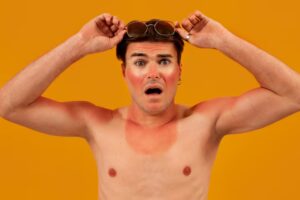As the summer season approaches, many people start to spend more time outdoors, soaking up the sun and enjoying various outdoor activities. While getting some vitamin D is important for our health, prolonged exposure to sunlight can lead to skin damage and other negative effects.
One common symptom of sun damage is the appearance of spots on the arms. These spots may be small or large in size, and can vary in color from light brown to dark red. They are commonly known as “age spots” or “sun spots” and are caused by excessive exposure to UV rays from the sun. Chances are, they’re sunspots, your skin’s way of waving a red flag after too much UV exposure. But not all discolorations are the same, and some may indicate deeper damage.
Common Types of Sunspots and Their Appearance
Since sunspots can show up in different ways, it’s helpful to know what to look for so you can spot them early. Should you notice flat, brown patches with a mottled appearance—these often appear on areas like your arms after years of sun exposure.
Some spots look like freckles but don’t fade in winter, while others have uneven pigmentation, making them stand out more. Solar lentigines (those small, dark patches) are common, but larger, irregularly shaped spots could signal something else. Pay attention to texture too; sunspots usually stay smooth, unlike rough, scaly patches that need a dermatologist’s check.
When you see clusters of tiny dots or blotches, that’s another sign of sun damage. The key is noticing changes early, so you can take action. Your skin tells a story, and these marks are its way of saying it’s had too much sun. Keep an eye out, and don’t ignore new or shifting spots.
How UV Rays Cause Skin Discoloration on Arms
Over time, UV rays from the sun can trigger uneven pigmentation on your arms, leaving behind those stubborn dark patches or blotches. Whenever your skin gets too much sun, it produces extra melanin—the pigment that gives your skin color—to protect itself. But with repeated exposure time, this process can go haywire, leading to splotches or darkened areas.
Cumulative UV damage adds up, especially on your arms since they’re often uncovered. The more you’re out in the sun without protection, the higher your risk of discoloration.
UV rays deteriorate collagen and elastin, making your skin less able to repair itself. That’s why older spots might linger while new ones pop up. Even brief bursts of sun add to the damage over years.
To minimize it, wear sunscreen daily, cover up with sleeves, and avoid peak sun hours. Your arms will thank you later.
Age Spots vs. Sunspots: Knowing the Difference
Those brown spots on your skin can look similar, but age spots and sunspots aren’t quite the same thing. Age spots, also called liver spots, often show up as you get older due to slower skin cell turnover and reduced skin elasticity.
Sunspots, on the other hand, are directly tied to UV exposure, which triggers extra melanin production. Both appear as flat, darkened patches, but sunspots tend to cluster in sun-exposed areas like your arms, face, or hands.
Age spots are usually larger and more uniform in color, while sunspots can vary in size and darkness. Should you have spent years in the sun without protection, you may notice more sunspots. Neither is dangerous on its own, but sudden changes—like irregular borders or rapid growth—should get checked.
Protecting your skin with sunscreen and wearing hats can help prevent new spots from forming.
Early Signs of Sun Damage You Might Miss
You couldn’t notice faint skin discoloration at the start, but those barely-there patches could signal early sun damage. Your skin’s texture might also feel slightly rough or uneven, even if it doesn’t look obviously damaged.
These subtle changes are easy to overlook, but catching them early helps you take action.
Faint Skin Discoloration
Regardless of whether you observe a sunburn, faint skin discoloration can be one of the initial subtle indications that sun damage has commenced. In the event that you notice uneven patches where your skin tone fading occurs, or small areas where pigment changes make your complexion look blotchy. These spots often appear on your arms, face, or chest—areas frequently exposed to the sun.
Unlike a tan, which darkens evenly, sun damage disrupts melanin production, leading to irregular coloring. Should you see these changes, it’s your skin’s way of saying it needs more protection. Wear sunscreen daily, seek shade during peak sun hours, and consider wearing protective clothing. Early attention helps prevent further damage, so don’t ignore these quiet warnings.
Subtle Texture Changes
Sun damage doesn’t always announce itself with obvious burns or dark spots—sometimes, it shows up in tiny shifts in your skin’s texture. You may notice subtle texture change patterns, like areas that feel rougher or drier than others, even if they look normal. These subtle skin surface irregularities can creep in over time, making your skin less smooth to the touch.
Pay attention to patches that seem slightly bumpy or uneven, especially on sun-exposed areas like your arms or face. These changes often start small, so it’s easy to overlook them. But they’re your skin’s way of saying it’s had too much sun. Moisturizing and wearing sunscreen daily can help, but once these textures appear, they’re harder to reverse.
Risk Factors That Make Your Arms More Prone to Sun Damage
When you have fair skin, you’re more likely to notice sun damage on your arms because they lack natural protection. Spending lots of time outside without covering up makes it worse, especially when you forget sunscreen.
Your arms get hit hard since they’re often exposed to direct sunlight.
Fair Skin Tone
Because fair skin has less melanin, it doesn’t have as much natural protection against UV rays, leaving your arms more vulnerable to sun damage. In the event that you have a pale complexion, your skin burns faster and shows sunspots more easily. Sensitive skin also reacts strongly to sunlight, often turning red or peeling. To safeguard yourself, wear broad-spectrum sunscreen (SPF 30+) daily, even on cloudy days.
| Fair Skin Risks | How to Protect Yourself |
|---|---|
| Burns easily | Apply sunscreen every 2 hours |
| Shows sunspots sooner | Wear long sleeves or UPF clothing |
| Prone to redness | Seek shade during peak sun hours (10 AM–4 PM) |
| Less natural UV defense | Use hats and sunglasses for extra coverage |
| Higher risk of damage | Check skin regularly for changes |
Your arms need extra care—don’t neglect protection!
Frequent Sun Exposure
Spending too much time outdoors without protection puts your arms at higher risk for sun damage. The more you expose your skin to UV rays, the more likely you’ll notice uneven pigmentation, like dark spots or patches.
Your arms are often left uncovered, making them vulnerable to sunburn and long-term harm. Over time, frequent sun exposure weakens your skin’s defense, leading to increased sensitivity, redness, or even peeling. Even as soon as clouds appear, UV rays can sneak in, so slathering on SPF 30+ sunscreen is a must.
Wearing long sleeves or seeking shade helps, but reapplying sunscreen every two hours is key. Don’t forget—your arms age faster when they’re constantly in the sun, so protect them daily.
When to Worry: Recognizing Precancerous Changes
While sun damage often shows up as harmless freckles or dark spots, some changes in your skin could signal something more serious. When you notice spots that grow, change color, or bleed, it’s time to pay attention. Regular skin cancer screening helps catch these early, and taking preventative measures can reduce your risk.
| Normal Spot | Warning Sign |
|---|---|
| Stays the same size | Grows or changes shape |
| Even color | Uneven or multiple colors |
| Smooth edges | Ragged or blurry borders |
| Doesn’t itch or bleed | Itches, scabs, or bleeds |
| Fades with time | Persists or gets darker |
Should you spot these changes, don’t panic—but do see a dermatologist. Early action makes all the difference. Your skin’s health is worth the extra care.
Effective Ways to Protect Your Arms From Further Sun Damage
- Reapply frequently: Sunscreen wears off, particularly after sweating or swimming. Set a reminder every two hours.
- Seek shade: Whenever the sun’s strongest (10 AM–4 PM), stay under cover or wear a wide-brimmed hat.
- Cover up: Lightweight, long-sleeved shirts or UV-blocking arm sleeves add extra defense.
- Hydrate your skin: Moisturize with aloe or vitamin E to repair sun-stressed skin.
- Check your medication: Some medications increase sun sensitivity—inquire with your doctor if yours do.
Small changes make a big difference.





